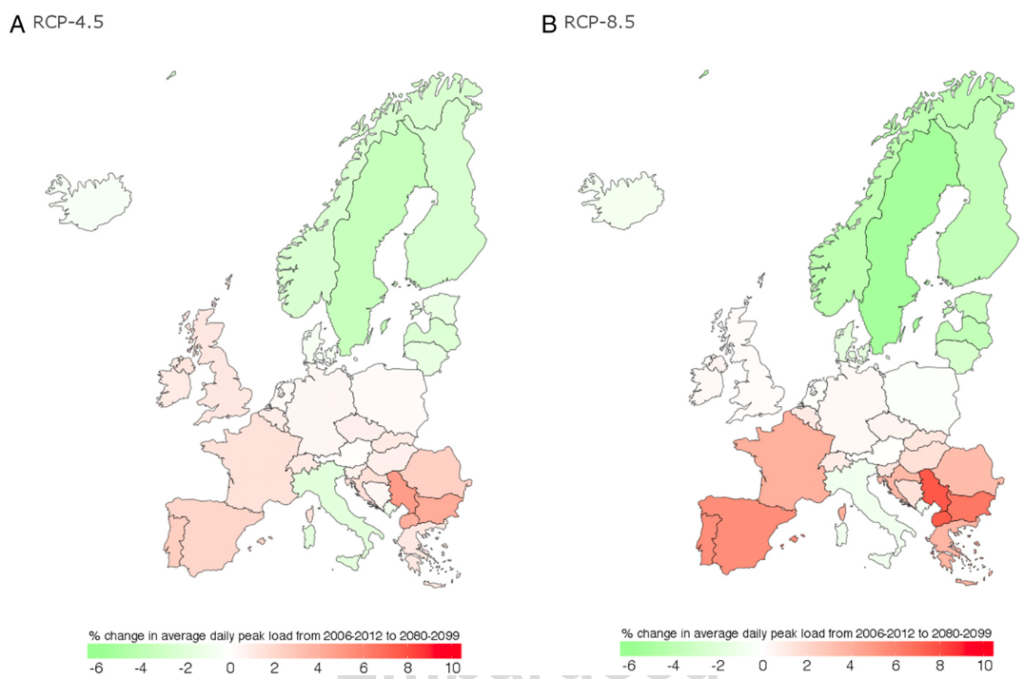
Climate change could flip European peak power demand to summer, study says
Jocelyn Timperley
08.29.17Jocelyn Timperley
29.08.2017 | 3:42pmClimate change could push peak electricity demand from winter to summer in most European countries, a new study says.
If global greenhouse gases aren’t curbed, rising temperatures will lead to increased use of air conditioners in the summer and less need for heaters in the winter.
Energy systems have traditionally been designed around the ability to meet demand on the day with the highest peak each year. If this day moves from winter to summer as a result of climate change, it will have significant impacts on grid planning, says the study, published yesterday in the Proceedings of the National Academy of Sciences.
The changes in peak demand will come as part of a wider shift in electricity consumption patterns across Europe, as temperatures rise and demand moves from colder northern countries to the warmer south.
Winter to summer
The study of 35 countries across Europe examines the impact of a warming climate on today’s electricity systems. It looks at three different greenhouse gas concentration trajectories, of varying ambition.
Only five of these countries currently see the year’s peak demand day in summer. Most instead require more electricity in the cold, dark winter months to keep homes warm and light.![]()
If emissions aren’t curbed (RCP8.5), the study finds peak electricity demand would occur in the summer for 24 of the 35 countries by the end of this century, as use of air-conditioners soars amidst rising temperatures.
Southern shift
These seasonal changes in peak demand are part of a broader picture where European power grids could also see marked geographical shifts, as temperatures rise over this century, the study shows.
Climate change will cause electricity consumption in southern and western European countries such as Spain and Portugal to increase significantly, the authors find, with their average daily peak increasing too.

Maintenance workers view air conditioning pipes, Hospital Donostia, San Sebastian, Spain, 23/03/2015. Credit: age fotostock / Alamy Stock Photo.
However, this rise in demand in the south of Europe will be balanced by a fall in demand in northern European countries like Sweden and Norway, as warmer winters require less electricity for heating.
This means the overall impact of climate change on the combined electricity demand of the 35 countries is neutral. But there will still be significant consequences for electricity grids.
It could affect where costly peak-generating capacity and transmission infrastructure is needed, for example.
Dr Leonie Wenz, a researcher at the Potsdam Institute for Climate Impact Research in Germany and lead author of the paper, tells Carbon Brief:
“Generally, generating and transmission infrastructure is designed to meet the highest demand in a year. Increases in peaks will put additional pressure on the grid when it is already stressed and will likely require additional investments in this infrastructure.”
The design of energy-efficiency policy and need for storage capacity could also change, the study says.
It’s worth noting that many of the Scandinavian countries which are expected to see a fall in demand have a higher share of renewables in their electricity mix than the southern countries where demand will increase. The shift in demand could therefore also affect climate change mitigation efforts.
Up or down
The map below shows which countries are likely to experience increased (red shading) or decreased (green shading) average daily peaks by the end of the century, under intermediate emissions (RCP4.5, map A, left) and where emissions are not curbed (RCP8.5, map B, right).

Change (%) in average daily peak demand from 2006–2012 to 2080–2099 for projected daily maximum temperatures under RCP4.5 (A) and RCP8.5 (B). The study keeps all factors other than climate change impacts constant. Source: Wenza et al. (2017).
Note that neither of these scenarios is in line with the ambition of the Paris Agreement (roughly equivalent to RCP2 .6). However, the north-south polarisation pattern remains even under RCP2.6, the authors note. ![]()
As can be seen from the map, the average of peak demand on each day of the year in the UK is expected to increase slightly under intermediate emissions and remain more or less at today’s levels if emissions are unchecked.
This reflects a combination of falling winter peaks and rising summer peaks as a result of warming. However, the UK’s peak demand day will remain in winter, according to the research, as it does for 10 other European countries including Norway and Denmark.
Of all the countries studied, Serbia sees the biggest increases. Its average daily peak rises by 5% under intermediate emissions and by 8% if emissions are unabated. Its peak electricity demand moves from winter to summer, as is the case for 18 other countries including France, Germany and Spain.
Sweden, meanwhile, sees the largest fall in average daily peaks, down by around 4% and 5% by the end of the century under the two scenarios.
Climate ambition
The graphs below show the relative change in electricity demand to the end of the century under low climate ambition (RCP 8.5, top panel), intermediate emissions (RCP 4.5, middle) or high ambition roughly in line with Paris (RCP 2.6, lower panel).

Change (%) in 5-year average daily electricity demand compared with the 2015–2019 average for projected daily maximum temperatures under different climate change mitigation scenarios. Source: Wenza et al. (2017)
The comparison shows that scenarios with lower carbon mitigation will lead to larger changes in electricity demand in both directions, as it increases in some countries and decreases in others.
It’s worth noting that differences between the three scenarios remain relatively small until 2050, due to inertia in the climate system.
This means the additional near-term costs of the increase in demand due to warming in many countries could be offset by carefully crafted policies over the rest of the century, the authors say. The main burden will fall on transmission infrastructure and peak-generating and storage capacity, they add.
As the general direction of their results remains true for the three different carbon emission scenarios, the authors argue they are likely remain valid for other climate models too.
Extrapolation
It’s worth noting that, in order to isolate the climate effects on the electricity system, the authors keep all other factors constant in their study. Changes in population and economic structure over the next decades, as well as the electrification of heat and transport could also have large effects on electricity consumption.
The authors set a common frame across countries of how electricity load will be affected by changing temperatures. This allowed them to look for changes due to the way countries use energy as temperatures rise, rather than just extrapolating current national data.
For example, summers in Scandinavian countries are not currently warm enough to warrant air conditioning, however, this could change with hotter temperatures. The researchers used data from other European countries, which do already use air conditioning, as a guide to future changes elsewhere.
On the other hand, differences between cultures may make this extrapolation too simplistic. The authors give an example of Swedes potentially having a much higher heat tolerance, resulting in lower use of air conditioning than in other countries.
The authors also don’t account for the potential uptake of alternatives to air conditioning for dealing with warm weather, such as the use of natural ventilation or shading.
The UK’s Committee on Climate Change (CCC) says reliance on air conditioning needs to be avoided as far as possible, since it adds to the urban heat island effect as well as increasing electricity bills and CO2 emissions. Passive cooling measures such as green roofs and passive ventilation systems are preferable, it says.
Prof David Sailor, professor of geographical sciences at Arizona State University, who was not involved in the study, says there is a “good likelihood” that actual outcomes will differ due to factors not represented. This would be the case with any study that attempts to explore future scenarios, he says. He tells Carbon Brief:
“[I]t may not capture current/future trends in energy-use intensity, proliferation of air conditioning, and country-specific trends in building construction, renovation, and management.”
Similarly, the extrapolation of the response functions across countries could lead to key differences in construction characteristics and human behaviour that would affect the projections being missed, says Sailor. He adds:
“Also, while the focus of the paper is entirely on electrical consumption, the analysis of energy consumption sensitivities in winter and summer, would seem to require that such analysis should account for the varying energy mix in each country, particularly with respect to how heating loads are met, currently, and into the future.”
Wenz, L. et al. (2017) North–south polarization of European electricity consumption under future warming, Proceedings of the National Academy of Sciences, doi:10.1073/pnas.1704339114
-
Climate change could push peak electricity demand from winter to summer in most European countries

